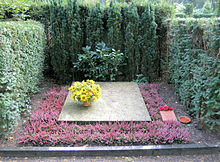Heinz Berggruen (Q66992)
Jump to navigation
Jump to search
art dealer, author (1914-2007)
| Language | Label | Description | Also known as |
|---|---|---|---|
| English | Heinz Berggruen |
art dealer, author (1914-2007) |
Statements
1 reference
3 references
1 reference
6 January 1914Gregorian
8 references
9 April 2014
Heinz Berggruen
9 October 2017
Heinz Berggruen
23 February 2007
8 references
9 April 2014
Heinz Berggruen
9 October 2017
Heinz Berggruen
1 reference
1 reference
1 reference
2 references
1 reference
1 reference
1 reference
1 reference
2 references
1 reference
La peinture, volée avec la collection Kann, se retrouve en 1940 au Jeu de paume, centre de triage des oeuvres pillées. En 1941, elle passe dans les mains du marchand allemand Gustav Rochlitz, qui collabore avec les services allemands. Elle sera ensuite acquise par le marchand parisien Paul Petrides, le galeriste suisse Marcel Fleischmann, le collectionneur André Lefèvre et le galeriste parisien Heinz Berggruen. Ce dernier prête l'oeuvre au Mnam en 1976, et la lui revend en 1981 9 millions de francs (French)
1 reference
1 reference
It appears that in 1942 the Nazis exchanged “The Guitar Player” — along with works by Matisse, Leger, Picasso and de Chirico — for an “Adoration of the Magi” by a German master. The Nazis considered most modern art “degenerate” and usually bartered such works for art that corresponded to their Aryan ideal, often trading several modern works for a single painting by a Dutch or German master. The Paris art dealer who received the painting in exchange for the “Adoration of the Magi” then sold the Braque, which had several owners before emerging at a 1948 exhibit with the mention “Collection of Andre Lefevre.” Upon Lefevre’s death, it was sold at auction in 1965 to Heinz Berggruen, a German-American collector living in Paris. A Braque by the same name, but painted in 1911, hangs in the Museum of Modern Art in New York. In 1976, Berggruen lent the painting to the Pompidou Center, which bought it in 1981 for some $1.5 million with a loan from the French government. Kann’s heirs have already recovered one Cubist painting from the Pompidou Center, (English)
1 reference
Born in Berlin on Jan. 5, 1914, Mr. Berggruen was working as a journalist for Frankfurter Zeitung, the forerunner of today’s Frankfurter Allgemeine Zeitung, in the mid-1930’s when he was informed that, because of his Jewish surname, his articles would in future be signed only by his initials, H. B.Soon afterward, he left Germany for the United States, where he studied art in San Francisco and eventually became an art critic for The San Francisco Chronicle. He joined the United States Army in 1942 and found himself in Paris at the end of the war. It was there that he opened an art gallery on the Rue de l’Université on the Left Bank.A turning point came in 1949 when the Dadaist poet Tristan Tzara introduced him to Picasso. “I was struck right away by his gaze,” Mr. Berggruen recalled later. The two men struck up a friendship that placed the dealer in a privileged position to acquire works by Picasso. In time, his Picasso collection exceeded 130 works.Mr. Berggruen’s taste also included late Impressionists like Van Gogh, Cézanne and Toulouse-Lautrec as well as the modern masters of the interwar years, including Braque, Miró and Klee. Works by many of these artists also entered his private collection and are on display in the Berggruen Museum in Berlin. (English)
Heinz Berggruen
0 references
Identifiers
1 reference
1 reference
1 reference
1 reference
1 reference
1 reference
1 reference
Heinz Berggruen
0 references
Sitelinks
Wikipedia(13 entries)
- arzwiki هينز بيرجروين
- cawiki Heinz Berggruen
- dewiki Heinz Berggruen
- enwiki Heinz Berggruen
- eowiki Heinz Berggruen
- eswiki Heinz Berggruen
- fiwiki Heinz Berggruen
- frwiki Heinz Berggruen
- nlwiki Heinz Berggruen
- nowiki Heinz Berggruen
- ptwiki Heinz Berggruen
- ukwiki Гайнц Берггрюн
- vowiki Heinz Berggruen
Wikibooks(0 entries)
Wikinews(0 entries)
Wikiquote(1 entry)
- dewikiquote Heinz Berggruen

